
views
X
Research source
If you ever find yourself facing the threat of a wildfire, it's important to know what to do to ensure that you and your family remain safe.
Recognizing Fire Conditions
Check when it last rained heavily. If it has been several months since the previous rainstorm, then it can get very dry. Dry shrubs and plants burn a lot more easily and more quickly than wet shrubs.
Analyze the wind forecast. Winds such as Diablo winds (in Northern California) or Santa Ana winds (in Southern California) allows for fire to spread more rapidly. These winds can carry hot ash and burning embers up or downhill, igniting more dry vegetation.
Be especially careful during the summer months. During this time, there may be lightning storms with little or no rain. These can ignite dry brush even at night. Stay tuned to the news for updates on the situation.
Read the fire danger. This is put up by your fire department to inform you of the risk of wildfires. If the fire danger is passed yellow, reconsider lighting campfires or launching fireworks.
Surviving on Foot
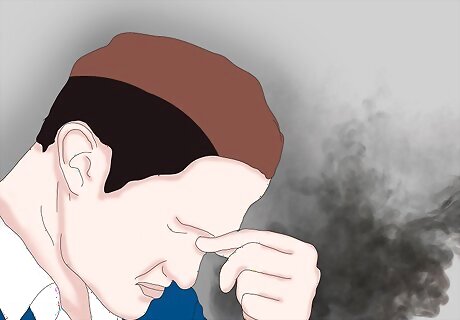
Remain calm. The situation is extremely dangerous, but panicking will only hinder your ability to adapt to the situation and survive. Breathing techniques are an excellent way to keep calm, if the air is not too smoky already. Take a deep breath in for four seconds, then exhale slowly for four seconds. Repeat until you feel more calm and in control, but again, if the air is already smokey you should not take deep breaths. Remain confident in your ability to escape and survive. Your mental condition will be an important factor in determining your ability to make it out alive.
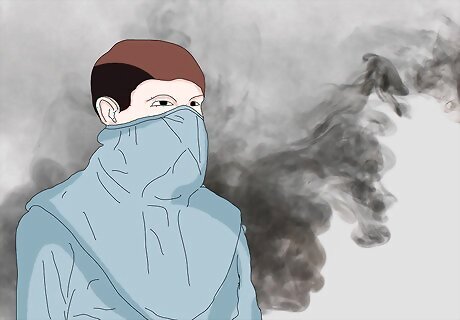
Protect your airways. This is the most important thing you can do to ensure your safety. Even if the fire continues to advance, you still have a chance of escaping if you can breathe. As soon as you start inhaling smoke and carbon monoxide, you're going to risk passing out and dying. Stay low to the ground. Cover your nose and mouth with a wet cloth, and hold it there until you get to safer grounds. If you are hiking, you should have water and some type of cloth with you, like a bandanna. Pour water over the bandanna and use it as a makeshift "respirator" until you escape. If the fire gets close, and heat rather than smoke become your biggest enemy, switch back to a dry cloth. Breathing through a wet cloth does help with smoke, but with a fire nearby, the heat can evaporate the water, making it harder to breathe and possibly damage your airways.
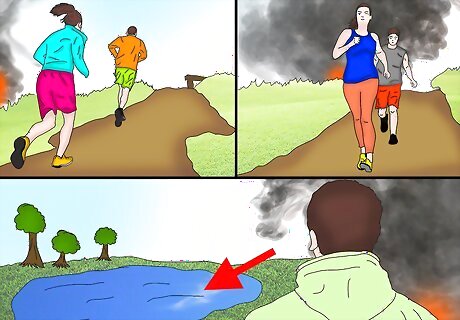
Determine three courses of action. If time and your mental condition allow it, try to formulate three different escape plans. Then you can quickly assess each of the options to find the most advantageous escape route, and if the situation changes and you need to adjust your plans you will already have two backups. Remember that the most dangerous places to be in relation to the fire are uphill from the flames and downwind from the fire. Try to stay upwind of the fire at all times. Use the wind as a guide. If the wind is blowing past you and toward the fire, then run into the wind. If the wind is behind the fire and blowing toward you, run perpendicular to the fire so that you are escaping both the actual flames and the course they will blow towards. Remember that winds can carry sparks and start new mini-fires up to one mile ahead of the existing flames. Do not allow yourself to become surrounded by fire.

Head for non-flammable terrain. If at all possible, head for the nearest, biggest area that is unlikely to burn. While the fire is probably wide and sweeping, it needs combustible material like trees, brush, and tall grass to burn. Look for nearby areas that are free of trees and brush. If you can put a water body between you and the fire, do so. Places which have already burned are sometimes the safest place to go, if you do not have any other options. However, you should ensure that the area is completely extinguished before proceeding, as lingering fires could cause burns and breathing problems.

Avoid high-burn places. As you flee the fire, you'll need to avoid places that could leave you trapped once the fire advances. If at all possible, avoid areas choked with a lot of vegetation, as these will almost certainly burn. Low-lying areas are generally considered safer, if there is not a lot of vegetation there. Stay away from canyons, natural "chimneys," and saddle-like ridges. These areas leave very few options if the fire suddenly spreads around you, and a canyon could leave you trapped in a dead end.
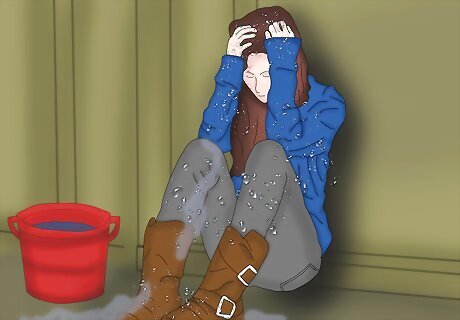
Hunker down if trapped. If the fire surrounds you, or if there is no place safe to head toward, your safest option may be to hunker down in an area that will not burn. However, if you are able to continue fleeing the fire and heading toward safety, you should do so. If at all possible, take refuge in a building or vehicle. If you are near a body of water, like a river or pond, seek safety in the water or use it to keep some distance between you and the fire. Fire will not burn across the water, unless it is a narrow creek with a lot of overhanging trees. If you are near a road or ditch but cannot follow the road to safety due to the width of the fire, you may be safest using the road as a barrier. Unless there are overhanging branches, the fire will take time to spread across the pavement. If you become trapped, lie face-down on the pavement as far from the fire as you can get. If there is a ditch on the far side of the road, lie in the ditch face-down. When you hunker down, try to cover your body with anything that will protect you from the fire. Wet clothing or a wet blanket are useful, but in a pinch even covering the back of your body with soil or mud may help keep you cool in the intense heat. Stay down until the fire passes.
Staying Safe in a Vehicle

Find a vehicle. If you are not in your own vehicle and your choices are running on foot or using a vehicle, opt for the vehicle. It's still extremely dangerous, but will give you better odds of surviving than being on foot. If you do not have your own vehicle but find an abandoned vehicle as you flee from the fire, enter the vehicle and hotwire the car. If you need to break a window to enter the vehicle, break a rear window so that the front windows can remain closed. This is important, as it will help keep smoke out of the vehicle. Do not break into and hot wire a car that someone is likely to come looking for. You should never take someone else's means of escaping the fire. This method is only really applicable if you find a car that someone clearly left behind to flee on foot.
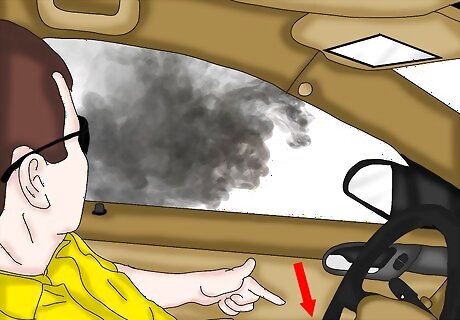
Ensure that you can breathe. Once you're in a car, you'll need to ensure that the car is safely sealed from the smoke surrounding you. This is crucial, since you will otherwise risk passing out from carbon monoxide. Roll up the windows and close the air vents.
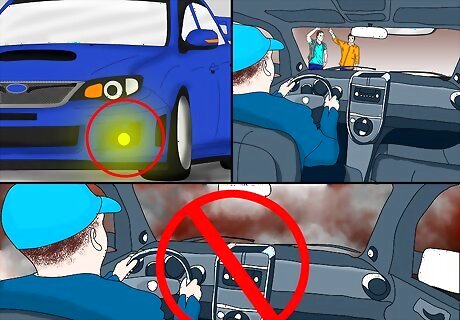
Drive if you can. If the vehicle runs and you're capable of driving it, then do so. But it's important to drive safely, so that you can see your surroundings and so that anyone else on the road can see you. Drive slowly and keep your headlights on. Keep an eye out for other vehicles and pedestrians. Stop to let any pedestrians you encounter ride along with you. Do not drive through heavy smoke. If the smoke is too thick to see where you're steering, it may be safer to park and wait it out. If you must stop the vehicle, park as far away from trees and heavy brush as possible.
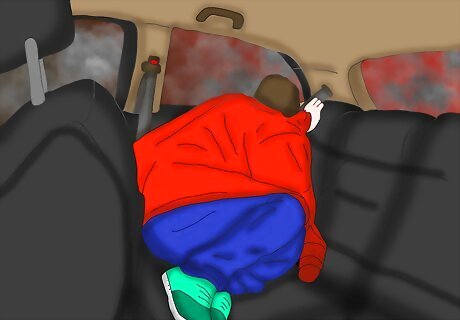
Remain in the vehicle. If the smoke is too thick to see the road, or if you cannot drive the car for any reason, you should remain in the vehicle. You will be more likely to be injured or killed by leaving the vehicle than you would be if you remained inside. Don't worry about the gas tank. Vehicles with metal gas tanks rarely ever explode. You are much safer staying inside the car than you would be on foot. Keep the windows up and the air vents closed. Lie down on the floor of the vehicle and cover yourself with a blanket or coat, if possible.
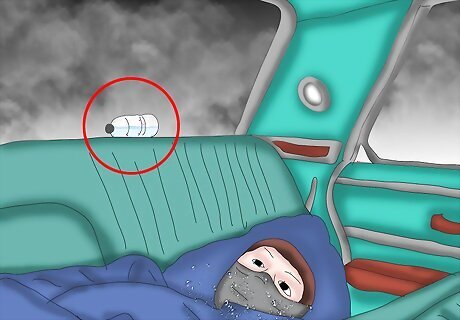
Know what to expect. Whether you are able to drive or you are forced to hunker down inside a vehicle, it's important to know what to expect so that you do not panic. Just remember that no matter what happens, if the fire surrounds the car you should not leave the vehicle. The temperature inside the vehicle will increase considerably. Don't worry - it's still safer inside the vehicle than outside. Air currents low to the ground may rock the car. Some smoke and even sparks may enter the vehicle. Don't be alarmed. Just stay low on the floor of the vehicle and keep breathing through a wet cloth to protect your airways.
Taking Shelter in a Building

Take any precautions you can. If the fire is rapidly approaching, you may not have time to take any precautions to protect the structure. However, if time permits, there are a number of things you can do to keep the building as safe as possible. Shut off any and all fuel lines, including propane, natural gas, and oil. Move curtains and fabric-covered furniture away from windows and sliding doors. If the glass breaks, you do not want anything flammable near the window/door. Remove any combustible objects from the yard, especially gas grills and fuel cans, and discard them as far from your structure and any nearby structures as possible. You should also move any stacks of firewood as far from the building as possible. If time permits, trim grass and vegetation as low to the ground as possible around the building and any external propane tanks. This will help reduce the combustible material that would allow the fire to reach you or the fuel source.
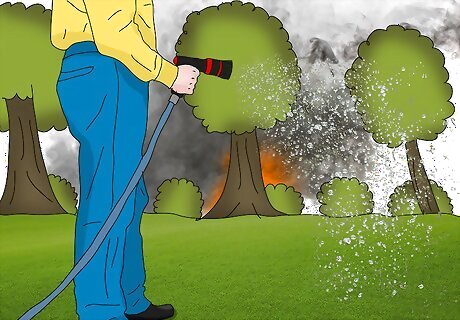
Try to wet the area. If the building has hoses and running water, utilize that water to create a safer structure. Remember that water may not necessarily stop a fire, but it will slow it down. Use hoses or sprinklers to saturate the roof of the building, the walls, and the ground immediately surrounding the building. Fill any large containers present with water (if possible), and surround the perimeter of the building with them.

Stay inside. Whether you become trapped in your home or you take shelter in a building you come across, stay inside no matter what. If the fire surrounds the building, you're more likely to survive inside than out. Close all the doors, windows, and vents in the building to prevent a draft from spreading the fire inside. Do not lock the doors to the building. If things take a turn for the worst and you need to escape, or if firefighters find the building, you'll want to ensure that the doors are not locked. Stay away from exterior walls. If the building is big enough, try to get into the middle of the structure, like a centrally-located room, so that you are as far from the exterior as possible. If you are with other people, stay together.



















Comments
0 comment